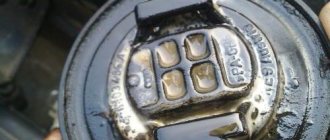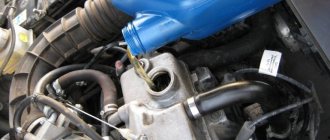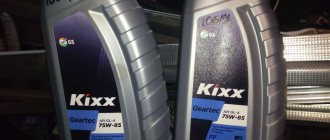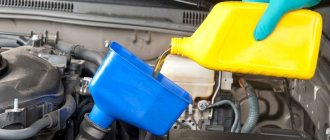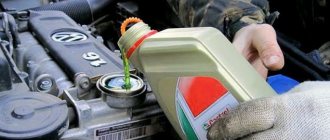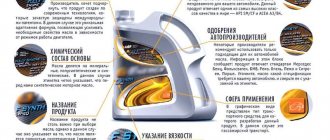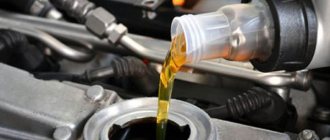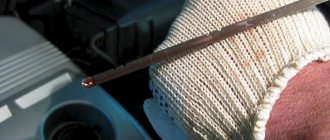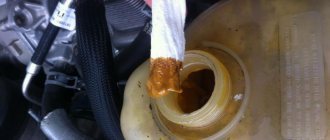Motor oil and coolant have different purposes and should not be mixed. However, sometimes antifreeze gets into the oil (and vice versa). Because of this, the motor begins to malfunction.
To prevent the negative consequences of antifreeze getting into the oil by identifying the problem in a timely manner, you need to understand what the signs of the presence of coolant in the lubricant are.
The most common factors by which you can understand that antifreeze has got into the oil
There are some signs of antifreeze getting into the lubricant. How to determine and detect antifreeze in oil:
- Reducing the amount of antifreeze, provided that it does not leak out of the car.
- The engine is shaking, the motor is running unevenly.
- Whitish traces of antifreeze on the dipstick.
- When you open the valve cover, you can see that it is white on the inside. There are also white spots inside the flask.
- Air bubbles are visually observed in the expansion tank at high engine speeds. There are grease leaks on the surface.
- Antifreeze is visible on the crankcase, spark plugs, under the head, in the pan.
- High concentration of exhaust carbon monoxide. The exhaust color is white, more like steam.
- The grease darkens quickly.
Elimination method
When a significant amount of lubricant gets into the antifreeze, the latter is unable to work as a coolant. It forms clots and even solid particles that settle on the walls of the channels, clogging the thermostat valve and clogging the radiator. There is also no guarantee that mutual penetration has not occurred and antifreeze has not leaked into the oil pan. Hence the conclusion: both liquids must be drained .
If your car is equipped with an oil cooler, immediately contact a service station to locate the broken gasket. Then decide whether to carry out the repairs yourself or entrust the work to car service personnel.
What to do if oil or emulsion is found in the expansion tank with antifreeze:
- Both systems need to be flushed. Before draining the antifreeze, add a special detergent composition to the expansion tank and let the engine idle for 5 minutes. Empty the lubrication system immediately.
- Unscrew and discard the oil filter.
- Replace the gasket on the cylinder block by removing the cylinder head. During the dismantling process, disassemble the elements of the cooling system (pipes, pump, thermostat) and thoroughly rinse them by hand. Do the same with the heat exchanger if it is the culprit for mixing liquids.
- Unscrew the oil pan and oil pump, disassemble the latter and change all gaskets. Before assembly, wash the parts with gasoline or solvent.
- Assemble the power unit, install a new filter and fill in engine flushing lubricant. Instead of antifreeze, fill the system with distilled water and add detergent.
- Start the engine and let it run for 10–15 minutes without increasing the speed. Keep an eye on the oil warning light and temperature gauge.
- When finished, replace the water with a working fluid - antifreeze, and the flushing oil - with full-fledged engine oil. It is highly advisable to change the filter twice.
Advice. When pre-flushing the cooling system before eliminating the malfunction, monitor the temperature and pressure of the lubricant. If you notice something is wrong, immediately turn off the engine, as the oil still gets into the antifreeze.
No matter how carefully you try to wash the engine parts during disassembly, you will not be able to get to all the channels. Therefore, flushing is performed several times, including after starting the power unit. During further operation, monitor the condition of the process fluids so that the problem does not recur.
Why does antifreeze get into the lubricant?
If antifreeze or its traces are found, you need to understand the path through which it gets into the lubricant and fix the problem.
Some possible reasons:
- The cylinder head gasket is worn, punctured, or deformed. There is no barrier for antifreeze to leak into the lubricant. This will clearly be observed on the spark plugs. They will be covered in whitish streaks of antifreeze.
- Poor installation of the cylinder head gasket. The head bolts are not tightened sufficiently or, conversely, they are overtightened.
- Lack of tightness of the heat exchanger.
- Head deformation due to harsh operating conditions, overheating.
- Poor quality antifreeze. Could freeze at low sub-zero temperatures. After thawing, such liquid leads to deformation of the block head. And also the use of low-quality fluid leads to the fact that the cylinder liners rust and collapse.
- The fluid pump is clogged or incorrectly installed.
How to change the gasket?
Let's consider the replacement procedure using the example of a VAZ-2109 car. To do this we need:
- Remove the air filter housing.
- Disconnect all fuel supply hoses and power wires.
- Drain the coolant.
- Unscrew the manifold.
- Disconnect high-voltage wires.
In this way, we free the head from everything unnecessary, so that nothing gets in the way when removing. To unscrew the head itself you need a powerful wrench and a hexagon. A total of ten bolts need to be unscrewed. The latter are removed along with the washers. Next, the head carefully rises up. It is important not to distort it. The gasket itself may remain on the head or stick to the block. You can remove it with your own hands or pry it off with a negative screwdriver. The surface of the cylinder head is inspected for corrosion. If there is rust, it will need to be milled and sanded. If all is well, you need to remove traces of the old gasket. Having cleared the surface of its residues, degrease the area.
What to do if antifreeze gets into the oil
Depending on how the antifreeze got into the oil, there are certain ways to troubleshoot problems specific to each case.
| Why does antifreeze get into the oil? | Method for eliminating the cause of antifreeze penetration into the oil |
| Worn cylinder head gasket | Remove and install the block head. Replace seal gasket. |
| The cylinder head gasket is broken. The antifreeze oil partition is cracked. | Crack repair. |
| The gasket is deformed. | Replacement of the internal part of the deformed head adjacent to the motor. |
| The gasket is poorly installed. | Reinstallation, high-quality tightening of bolts. |
| Low quality antifreeze. | Replacing the fluid with a high-quality one. Repair, replacement of gaskets and cylinders. |
| The fluid pump is not installed correctly. | Reinstalling the pump. |
Car oil in antifreeze
The opposite also happens. When motorists see traces of grease on the walls of the expansion tank, they ask themselves the question: “Why is there oil in the antifreeze?”
The car oil from the lubricating complex somehow ends up in the cooling system, but everything is fine with the oil liquid. Its volume, shade, viscosity do not change.
You may be interested: What are the consequences of a high oil level in an automatic transmission?
Experienced drivers in such situations say: “The end of the cylinder block.” Usually these words are true. Through a crack in the block, part of the lubricant enters the cooling complex and curls up there. An emulsion is formed.
It is almost impossible to replace the cylinder block on your own. You must contact a specialized service center.
What are the consequences for the engine when antifreeze penetrates into the oil?
Antifreeze is a liquid mixed with concentrated additives: pure water. Additives prevent water from freezing at low negative temperatures.
Antifreeze gets into the oil and causes its lubricating and protective properties to change dramatically. The additives that make the oil a unique material capable of preventing the engine from dry friction, ensuring optimal engine performance at different ambient temperatures, are destroyed.
As a result, the engine wears out quite quickly. Cooling antifreeze, being in the oil, leads to the fact that the consequences for the engine can be catastrophic. There may be a knocking sound in the crankshaft and camshaft. It appears due to abrasion of the friction layer of the liners. When viewed under microscope magnification, white balls of salt are visible on the inserts. They are the cause of abrasion and corrosion of the liners. They are formed as a result of a chemical reaction between lubricant additives and antifreeze additives. During operating mode, the oil heats up and speeds up the reaction.
Another reason for engine problems is that oil additives dissolve better in water than in oil. Antifreeze is water based. Even a small amount destroys a large percentage of additives. Thus, the oil base ceases to have the protective properties declared by the manufacturer. This is why antifreeze is dangerous for lubricating fluid.
Coolant and antifreeze getting into the oil eventually lead to a major overhaul of the engine if the cause of the penetration is not eliminated in time. Even tenths of a percent of coolant in oil are very dangerous for the engine.
In order to promptly notice and eliminate this kind of malfunction, as well as see leaks, you can coat the engine with silver paint that is not afraid of high temperatures.
Antifreeze (antifreeze) in engine oil, why?
The appearance of coolant (antifreeze, antifreeze) in the engine oil is almost always a signal for immediate engine repair.
Using the example of engine 21083 of VAZ 21093, 21083, 21099 cars, we will figure out what the signs of this malfunction are, how the coolant got into the engine oil and whether something can be done about this problem.
Signs of the presence of antifreeze (antifreeze) in motor oil
— After parking the car, there is a light (light yellow or light brown) emulsion on the dipstick on top of the oil level.
— The same emulsion coating may be on the oil filler cap and on the inner surface of the valve cover.
— The coolant level is constantly decreasing. In some cases, the decrease may be slight and unnoticeable, but most often the decrease will be very noticeable. At the same time, there are no visible coolant leaks on the engine cooling system parts.
— Oil stains have appeared on the surface of the coolant in the expansion tank.
— The engine constantly overheats. Overheating is accompanied by strong bubbling in the expansion tank.
— Suddenly, the electrodes of one of the spark plugs became clean, but it began to work intermittently. The engine will start.
— Copious white smoke appeared from the muffler. Which does not go away as the engine warms up.
Reasons for the appearance of coolant (antifreeze, antifreeze) in engine oil
— “Broken” engine head gasket
It is no secret that this gasket seals the channels of the lubrication system, cooling system and combustion chamber. Most often, one of the gasket jumpers between the combustion chamber and the cooling jacket channel of the engine block (channels around the cylinders) burns out. In this case, antifreeze or antifreeze under pressure will enter the combustion chamber, disrupt the composition of the fuel mixture, and the cylinder will stop working or work intermittently. The oil will be washed off from the cylinder walls and, together with the coolant, will enter the engine crankcase, where a light emulsion will form.
In addition, gasoline and oil from the gas cylinders will be released from the combustion chamber into the cooling system. And this is, at a minimum, oil stains in the expansion tank, and at maximum, excess pressure in the cooling system.
Why does the head gasket burn out? First of all, this is a consequence of its destruction when the engine overheats. In addition, there may be a misaligned installation during engine repair or poor quality of the repair part. See “Burnt engine head gasket, signs and causes of malfunction.”
Car engine head gasket with channels and holes
— Cracks in the cylinder block or head of the car engine
The consequences of the appearance of such cracks or microcracks will be similar to those described above. As a rule, they also appear after the car engine overheats.
— Urban vehicle operation mode
Short, short trips, the engine does not warm up, or warms up, but idles for a long time. In this case, water condensate is removed from the oil less efficiently.
- Temperature changes
Warm during the day, cold at night. In such weather conditions (especially when the temperature difference is significant), a decent amount of water condensate from the internal surfaces of the engine enters the oil.
— Low quality motor oil
Low quality motor oil will cause a white foamy residue on the engine oil filler cap. Foaming of motor oil worsens its lubricating properties and directly affects the life of the car engine.
What to do if antifreeze (antifreeze) is found in engine oil?
If it is determined that the cause of coolant getting into the engine oil is a burnt-out head gasket, then there are no options other than replacing it. At the same time, it is worth checking the geometry of the mating surface of the block head, as it may “lead” if it overheats. Then only grinding and replacing the gasket will help.
If there is any doubt that the gasket is faulty, then first you should take a long trip at high speed. Condensation and moisture from the engine oil, as well as deposits on the dipstick and cap will disappear. After that, we insulate the engine so that in future it will warm up to operating temperature faster and clean the crankcase ventilation system to improve its efficiency in removing vapors and gases from the engine.
In addition, we replace the engine oil with a higher quality one that is suitable for the given engine. See “Choosing engine oil for the VAZ 2108, 2109, 21099 engine.”
If after replacing the gasket the symptoms of coolant getting into the oil remain, most likely there are microcracks in the cylinder block or cylinder head.
Notes and additions
— Coolant (antifreeze, antifreeze) getting into the engine oil is one of the malfunctions that needs to be corrected as soon as possible, as this reduces the lubricating properties of the oil and causes severe wear of the engine’s rubbing parts.
Twokarburators VK - More information on the topic in our VKontakte group, on Facebook Twokarburators FS and on Odnoklassniki - Twokarburators OK
More articles on engine malfunctions of VAZ 21093, 21083, 21099 cars
— The radiator fan is constantly running on VAZ 2108, 2109, 21099
— The car engine does not warm up, why and what to do?
— What to do if the car engine boils?
— Burnt out valve, signs and causes
— The exhaust pipe of the muffler turns black, why?
Diagnostics
When the cylinder head gasket
(cylinder head) burns towards the engine compartment, the location of the leak of antifreeze or other liquid from the cooling system can be easily determined by the drip. This is provided that the engine is supervised and washed regularly.
Especially cultured drivers, in order to quickly identify leaks of various fluids circulating in the engine, paint it in heat-resistant silver and regularly wash the engine itself.
On silver, all leaks are detected instantly, which allows you to quickly eliminate the problem. Of course, it is impossible to quickly determine anything on a dirty engine. But freshly squeezing antifreeze out from under the head there is a chance to see it.
The presence of antifreeze in oil is determined by three criteria:
- firstly
, the color and saturation of the exhaust gases change, they become white and swirl with thick steam, in winter it is this steam that confuses drivers - try and determine whether antifreeze has got into the oil or is it from the frost; - secondly
, as an additional check, the color of the oil is checked on the dipstick; if it has recently been changed, but has already turned black, then there is a high probability that antifreeze has got into it; - thirdly
, although slowly, the level of coolant liquid in the distribution tank will decrease every day.
A gradual decrease in the volume of antifreeze is not scary, and may indicate the presence of a breakdown in the gasket
, as well as for leaks in the main line connection bridges or microcracks in the hoses. An exchange of antifreeze and oil can also occur in the heat exchanger due to a leak in the seal.
When the issue concerns only antifreeze, its timely detection of getting into the oil will not cause serious or irreversible processes with the rest of the engine systems.
The situation will be worse when the system contains not antifreeze, but antifreeze diluted with water. In this case, you can expect everything from the engine, including overheating and deformation of the cylinder head.
Fault detection
This problem, or rather, a serious breakdown, is quite insidious and does not appear immediately. Liquid lubricant passes through microcracks in small portions, without having a particular effect on the operation of the power unit. Changes become noticeable at the next stage, when the channel connecting the two systems expands and the mixing speed increases.
How to determine whether lubricant has gotten into antifreeze:
- due to the deterioration of the cooling properties of antifreeze, the engine begins to heat up more often, the electric fan operates more often;
- the oil level gradually decreases, and the antifreeze level increases (it’s quite difficult to notice);
- the pump impeller whips up the oil-water mixture, turning it into a thick white emulsion that clogs the filter, causing the engine lubricant pressure to drop;
- drips are visible on the outside of the block or heat exchanger body, originating near the gasket (they do not always appear);
- the oil in the expansion tank changes the color and consistency of the coolant.
Important! The most obvious sign of mixing, monitored visually, is a white emulsion in the expansion tank with antifreeze. If you find a similar substance in the tank, compare this fact with other symptoms - constant overheating of the engine and signals from the oil level warning lamp.
As a rule, trouble does not come alone. Antifreeze that gets into the oil pan can create serious problems: at best, the emulsion will clog the lubricating channels and filter. In the worst case scenario, the crankshaft will rotate the bearings (sliding bearings) as a result of oil starvation. Expensive repairs are guaranteed.
Often the gasket bursts all the way to the cylinder walls, after which antifreeze gets into the combustion chambers (its channels are closer). The sign of a breakdown is clearly visible - white smoke pours out of the exhaust pipe in large quantities, and the engine power drops sharply.
When a similar problem occurs on a machine equipped with a heat exchanger - a motor lubricant cooler, diagnostic difficulties arise. If there are no external signs in the form of drips, then after identifying the emulsion in the expansion tank, it is better to contact a car service center. There, both units will be purged with a special installation and the culprit will be determined by air leakage.
What consequences might a violation have?
Oil getting into the refrigerant is very unpleasant. The consequences of such a violation can be very serious. In the future, serious repairs will be required and you will have to spend a lot of time restoring the car’s functionality. The consequences of a violation include:
- rapid and complete wear of bearings;
- motor jamming. Such a breakdown is often observed in diesel engines;
- oil filter contamination.
When mixing oil with antifreeze, a reaction occurs between the substances. Corrosion appears in the motor, and the bearings begin to rub against other parts. A serious load on all elements of the system leads to rapid breakdown of the vehicle. Soot can settle on the parts, which later gets into the filter, which also leads to breakdown. You can’t drive such a car, but it’s better to get it repaired as quickly as possible.
Why is water or coolant in oil dangerous?
If water and coolant get into the lubricant, the density invariably increases, while the fluidity decreases, as a result of which the engine is poorly lubricated and increased wear occurs. As a rule, the piston pins, camshaft and crankshaft are affected. If the car owner, in the presence of such problems, does not repair the engine, this leads to complete failure of the power unit, which can no longer be restored.
The resulting emulsion can get into hard-to-reach cavities, where it will soon coke, which leads to the pistons getting stuck in the rings. It should be said that repairs in this case will be very difficult, since washing out such contaminants and coked oil will be problematic. It is necessary to completely open the engine, eliminate the cause of water getting into the oil, and also perform a complete cleaning of the engine.
If there is water in the oil, problems are observed in the operation of the piston group, which in turn leads to increased fuel consumption.
The coolant will go into the oil, and therefore certain difficulties will arise with cooling the engine. As a rule, this leads to an even greater aggravation of the problem, the geometry of the valve cover and engine jacket is disrupted, numerous cracks appear, and as a result, it is not possible to repair such an engine and the damaged motor has to be replaced.
Reasons for oil getting into antifreeze and how to eliminate them
Mixing motor lubricant with engine coolant is a critical malfunction that requires immediate intervention and elimination. In other words, the car cannot be operated, only repaired. Although infrequent, this problem occurs on new and used cars. To avoid costly repairs, the car owner must clearly understand the procedure for his actions when oil is found in antifreeze.
What's next?
Install a new gasket. When installing, you need to pay attention to the fact that the gasket coincides with the guides that are on the corners of the block itself. Next, the block head is mounted. It is important that the gasket does not move during this process. Next, tighten the bolts with a torque wrench in three stages:
- 20-25 Nm.
- 70-85 Nm.
- 120 Nm. Afterwards the bolts are tightened with a force of 140 Nm.
At the next stage, all attachments are assembled, and the car will be ready for use. When starting for the first time, you need to warm up the internal combustion engine to operating temperatures, and only after that make the first trip.

